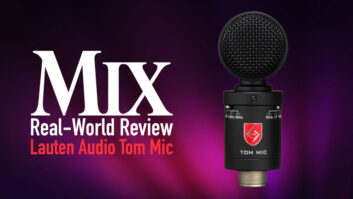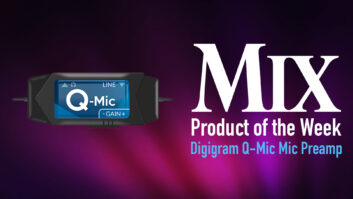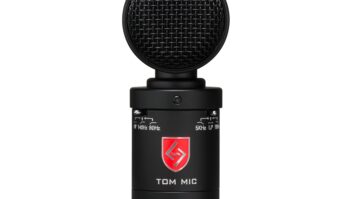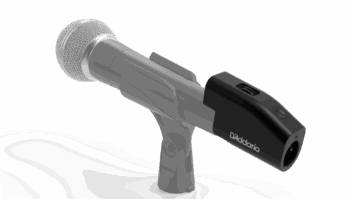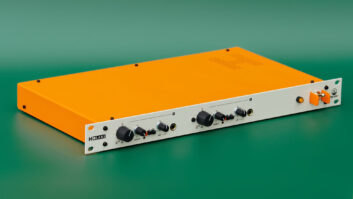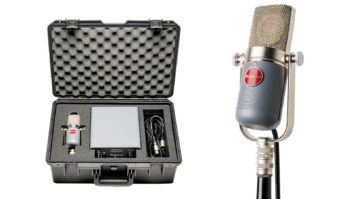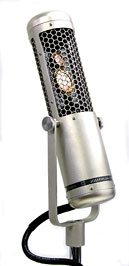
The Josephson Engineering C700A is an ingenious condenser mic with two front-facing capsules. This design permits nearly total directional-pattern flexibility by carefully mixing the two capsule’s output signals. The C700A is not an M-S or X/Y stereo microphone; rather, it has a 16mm-diameter omni capsule that responds to pressure, and is mounted above a pressure-gradient, 26mm figure-8 capsule. For recording events in anything from mono to stereo to three-dimensional surround, Josephson also offers the C700S, which adds a side-facing figure-8 capsule.
SOMETHING BORROWED, SOMETHING BIG
Both the C700A and -S borrow greatly from Josephson’s Series Six microphones, with omni capsules that are similar to the KA11 model and Class-A, transformerless J-FET impedance-converter/head amps. The gold-layered, 5-micron-thick Mylar capsules are manufactured in-house. To preclude the need for an external shock-mount, the capsules are mounted in a brass yoke assembly and placed in rubber shock-mounts that are installed between the polyacetal (polyoxymethylene) resin upper and lower half-domes.
The C700A is a sizeable 4.2-pound unit, which accommodates the dual shock-mounted capsules and two sets of electronics, and allows adequate space around the capsules for proper acoustical mixing of sound sources. Its 328mm-long/63mm-diameter, nickel-plated machined brass body has large sound-entry holes backed with black oxide-plated, stainless-steel mesh. The latter provides durability and electrostatic shielding. The mic’s increased mass/size means stability — less resonance when coupled between the U-shaped swing mount and the mic stand.
The C700A comes in a cushioned Pelican case with a 12-foot attached cable. A single 7-pin XLR male connector is used with an included “Y” adapter that fans out to two standard XLR connectors — one marked “W” and the other labeled “X.” If the adapter is misplaced or lost, the mic is unusable.
OPTIONS GALORE
I first used the C700A to record a Martin D-28 acoustic guitar. The front side of the mic was five feet in front of and facing the sound hole. I used a GML Model 8200 preamp with 55 dB of gain, and fed two tracks in a Pro Tools HD rig running at 88.2 kHz. I used no EQ or compression. The C700A has no roll-off or attenuation switches; it can withstand greater than 142dB SPL before overload.
Both the omni capsule (the W channel) and figure-8 capsule (the X channel) output the same level, which makes it easy to record and mix the mics to two tracks. I used the studio’s API console to mix Pro Tools mic track outputs. The omni sounded clear and openly ambient, yet remarkably “close” despite its distance from the source. The figure-8 sounded closer with more low frequencies and dryer with less of the surrounding room. If you mix the omni and figure-8 channels equally, then the in-phase components of both are added to produce a cardioid pattern.
Varying the ratio of the W channel to X channel changes the shape of the pattern. With no X channel added, the result is omni; hypercardioid when W is 10 dB lower than X; or wide-cardioid when the W channel exceeds the level of the X channel by a significant amount.
I recorded a Gibson Hummingbird acoustic with the C700A close up, aimed at the 12th fret and at a typical pop music distance of less than six inches. This time I recorded the blend of the two capsules using two Neve 1084 modules and the sidecar’s mix bus. I got a fatter and bigger sound due to proximity of the figure-8 capsule and the signal chain. The sound was good for a song that required a featured, front-line acoustic guitar.
After recording vocals, I remixed the mic channels inside Pro Tools, using the Trim plug-in to precisely change the gain or the phase of either the W or X channels. I had a male singer positioned three feet from the mic, and again, he sounded much closer than he physically was. This singer is notorious for “blowing up” boutique condenser mics, but not the C700A. Before adding the pad, the PreSonus M80 mic preamp distorted, but not the mic. I found the mic’s sound to be clear, realistic, noise-free and quite neutral without a hyped high end or midrange.
Remixing each pair of tracks in a triple-tracked backing vocal passage greatly increased the depth of the finished background vocal stem. I also tried equalizing and compressing the X channel differently from the W. Rolling off the X channel’s low frequencies decreases the proximity effect, while boosting the W signal’s high frequencies accentuates the room’s ambience. I also found compressing the omni signal greatly increases ambience, letting the uncompressed figure-8 signal “speak” better.
I also used the C700A as an overall drum kit mic by placing it about five feet in front, at rack tom height. Panning the two capsule signals left and right produced a very wide mono room track, making it a solid, mono-compatible alternative to stereo room miking.
FLEXIBILITY DEFINED
The C700A is a unique tool that allows you to explore and experiment with mic patterns and the subsequent shift in tune, after the recording, during the mix. The C700A is great for accurately documenting any acoustical event. The C700A would make an impressive addition to any music recording studio or Foley pit, or for picking up location/ambient sound. Price: $5,200.
Josephson Engineering, 831/420-0888, www.josephson.com.
